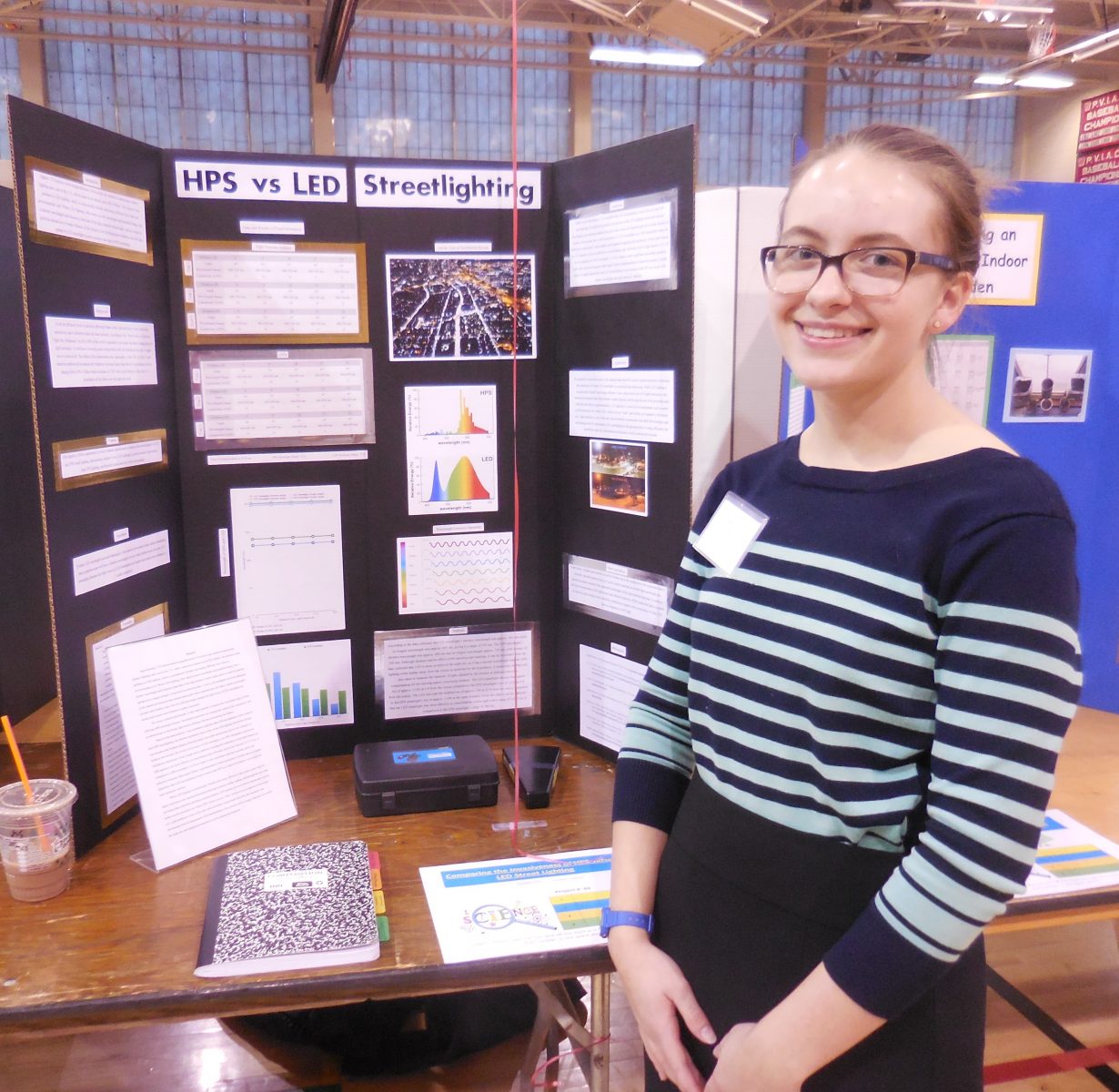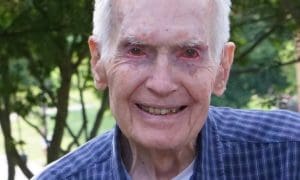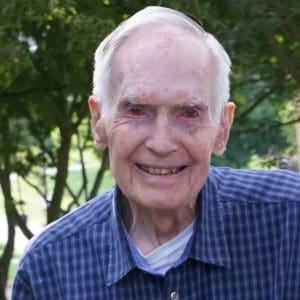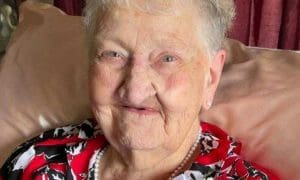
Senior Elizabeth Hoffman took first place for her project comparing street light pollution. (Photo by Amy Porter)
WESTFIELD – The Westfield High School’s Annual Science and Engineering Fair was held on Thursday. Projects were judged throughout the day, and the doors opened to the public at 5 p.m.to view the projects students had worked on for many months.
During the award ceremony, Principal Charles Jendrysik said this was the first fair he had seen, as last year’s was snowed out, and he asked for applause for the efforts of all the students.
In introducing lead science teacher Donna McKay, he said she spent Wednesday’s snow day setting up the gymnasium for the fair. McKay introduced co-coordinators Renee Sweeney and Debra Aldrich, who announced the top 15 projects and five runners-up. Sweeney said she hoped to send all 20 projects to the Region I Fair at the Massachusetts College of Liberal Arts in North Adams.
Many of the projects had an environmental aspect to them, as students sought to solve problems ranging from clean water to deterring pests without using toxic chemicals.
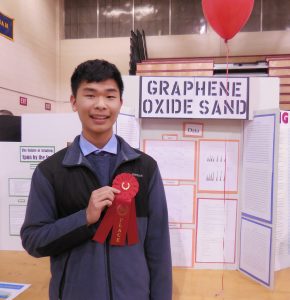
Senior Donald Chang said he did not expect to win second place in the Science Fair. (Photo by Amy Porter)
First prize, which was a $300 Amazon gift card. went to senior Elizabeth Hoffman for “Comparing the invasiveness of HPS versus LED Street Lighting.” Hoffman said there is a widespread belief that white LED is a cleaner light source than orange HPS. By measuring the wavelengths using a spectroscope in combination with a Digital Lux Meter, she learned that LED’s shorter wavelength takes longer for the light to scatter completely, penetrating further into the night sky. Her conclusion was that LED street light is more invasive and has higher intensity. Hoffman plans to study environmental science at the University of Massachusetts in Amherst.
Second prize, a $200 Amazon gift card, went to senior Donald Chang for “The Purification effect of Graphene Covered Sand on Macromolecules.” Chang said Graphene oxide, a natural carbon product, can be used as a water treatment to filter out dyes, toxins and dirt. He said graphene, which you can get from putting scotch tape to a pencil then further reducing the particles, is easy to take apart, is flexible, and is used in everything from batteries to solar power. Chang said because it is easy to make and easy to maneuver, it is an efficient and safe way to remove toxins in waste water.
Chang, who plans to study mechanical engineering, and hopes to go to Northeastern University, was surprised by his second place finish. “I did not know this was going to happen, honestly. I did put a lot of work into it. My peers are so hard working, I see myself as only equal to them, at most,” Chang said after the announcement.
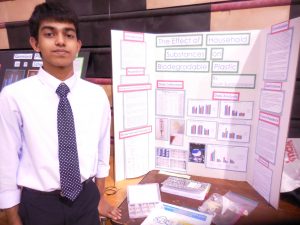
Third prize winner, freshman Suvin Sandararajan sought to create a biodegradable plastic-alternative. (Photo by Amy Porter)
Third prize went to a freshman, Suvin Sundararajan, who received a $100 Amazon gift card. His project, “The Effect of Household Substances on Biodegradable Plastic,” sought to create an organic plastic substitute as an alternative to plastic, which he called “toxic and polluting our environment.” His recipe used cornstarch, glycerin, water and vinegar in changing proportions to create the plastic substitute. His conclusion: “the more starch the better.”
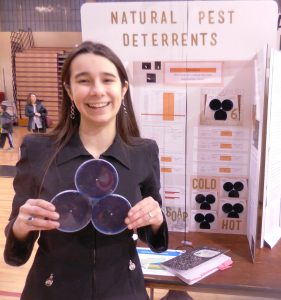
Senior Cassidy Pawul studied natural deterrents on termites. (Photo by Amy Porter)
Senior Cassidy Pawul places fourth on a continuation project from last year, which dealt with whether termites could be deterred with natural deterrents, such as catnip, orange and lavender oil. This year, she explored just how effective orange oil, the most effective of her experiment last year, could be made as a deterrent. Using a three-chambered box, she placed five termites in two chambers with an orange-oil treated cotton fabric. She then washed the fabric with cold and hot water, to simulate rainwater, which reduced the effectiveness to six hours. Her conclusion was that if orange oil were to be marketed commercially, it would have to be more concentrated and in a solution to make it more viable. Pawul, who plans to study English and French at Williams College, said she believes the deterrent would also work on ticks, which she said have similar tastes to termites regarding scents.
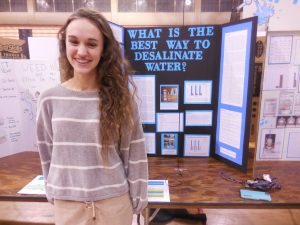
Senior Leena LaFlamme studied ways to desalinate water. (Photo by Amy Porter)
Senior Leena LaFlamme, who also placed in the top 15 and will be attending the regional science fair, also focused on clean water in her project “What is the best way to Desalinate Water?” She compared two different versions of desalinization of salt water, freezing and thermal (heat). She also geared the experiment toward underdeveloped nations. She found that thermal distillation is the best method, which cleared 99% of the salt, compared to freezing, which cleared only 61%. LaFlamme plans to study occupational therapy at Sacred Heart University.
The complete list of winners and runners up included:
1. Elizabeth Hoffman, Comparing the invasiveness of HPS versus LED Street Lighting
2. Donald Chang, The Purification Effect of Graphene Covered Sand on Macromolecules
3. Suvin Sundararajan, The Effect of Household Substances on Biodegradable Plastic
4. Cassidy Pawul, Natural Pest Deterrents
5. Liam Coffey and Zach Medeiros, Maximizing Wind Power Efficiency using Nose Cones
6. Catherine Morrissey and Elizabeth Reginer, How does temperature Stimulus on Drosophila melanogaster Activity Level and Reproduction Rate
7. John Peloquin, How clean is your shower pouf?
8. Evelyna Legkodukh, Applying Various Cable Designs to Maximize Tension Flow
9. Devun Nadeau and Ryan Paro, Waste Not, Want Not
10. Leena LaFlamme, What is the Best Way to Desalinate Water?
11. Kyle McCaffery, Conductivity and Weight, Copper, Aluminum, Maybe Both
12. Renee Suhocki, Comparing the cost, longevity and voltage of 3 different battery types
13. Brigid Moriarty, Effects of Phone Screens on the Eyes
14. Eric Bone and Jackson Diltz, Magnetic Helmets vs. Electromagnet Helmets
15. Alexis Reyes, Electrolyte Challenge: Sports Drinks vs. Other Drinks
Runners-up:
Adrian Orszulak and Kristen Stawasz, Designing a Lead Test Kit: A Solution to the Shortcomings of Others
Kaela Mochak, What’s in Your Water?
Amelia McNeice and Madison Rodriguez, Detecting Geomagnetic Storms in the Ionosphere
Aiden Chisholm and Brendan Morrissey, Analysis of Microbes Cultured from Keys of a Computer
Jason Gustafson, Hello-tracker

